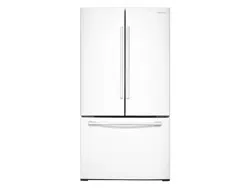Documents: Go to download!
User Manual
- User Manual - (English, French, Spanish)
- Energy Guide - (English)
- Specification Sheet - (English)
- Spec Sheet (web) - (English)
- Safety information
- Setting up your French Door Refrigerator
- INSTALLING
- Operating your French Door Refrigerator
- Troubleshooting
Table of contents
User Guide
Safety information
CRITICAL USAGE WARNINGS
- Do not insert the power plug into a wall socket with wet hands.
- Do not store articles on the top of the appliance.
- When you open or close the door, the articles may fall and cause personal injury and/or material damage.
- Do not insert hands, feet or metal objects such as knives, etc.) into the bottom or the back of the refrigerator.
- This may result in an electric shock or injury.
- Any sharp edges may cause a personal injury
- Do not put a container filled with water on the refrigerator.
- If spilled, there is a risk of fire or electric shock.
- Children should be supervised to ensure that they do not play with the appliance.
- Keep fingers out of “pinch point” areas.
- Clearances between the doors and cabinet are necessarily small. Be careful when you open the doors when children are in the area.
- Do not let children hang on the door. A serious injury may occur.
- Do not let children go inside the refrigerator.
- Children could become trapped.
- Do not insert your hands into the bottom area under the appliance.
- Any sharp edges may cause personal injury.
- Do not let children step on a drawer cover.
- The drawer may break and cause them to slip.
- Do not overfill the refrigerator with food
USAGE CAUTIONS
- Use only the ice maker provided with the refrigerator.
- Have the refrigerator’s water supply connected only to a potable water supply. To operate the ice maker properly, water pressure of 20 ~ psi (138 ~ 862 kPa) is required. If you will be away from home for a long period of time on vacation, for example) and won’t be using the water or ice dispensers, close the water valve.
- Otherwise, water leakage may occur.
- If you won’t be using the refrigerator for a very long period of time, (3 weeks or more) empty the refrigerator including ice bucket, unplug it, close the water valve, wipe excess moisture from the inside walls, and leave the doors open to prevent odors and mold.
CLEANING CAUTIONS
- Do not directly spray water on the inside or outside the refrigerator.
- There is a risk of fire or electric shock.
- Do not use a hair dryer to dry the inside of the refrigerator. Do not place a lighted candle in the refrigerator to remove bad odors.
- This may result in an electric shock or fire.
- Remove any foreign matter or dust from the power plug pins. Do not use a wet or damp cloth when cleaning the plug.
- Otherwise, there is a risk of fire or electric shock.
- Before cleaning or performing maintenance, unplug the appliance from the wall socket.
- Failing to do so may result in an electric shock or fire.
- Use a clean sponge or soft cloth and a mild detergent in warm water to clean the refrigerator.
- Do not use abrasive or harsh cleansers such as window sprays, scouring cleansers, flammable fluids, muriatic acid, cleaning waxes, concentrated detergents, bleaches, or cleansers containing petroleum products on exterior surfaces (doors and cabinet), plastic parts, door and interior liners, and gaskets.
- These can scratch or damage the material.
- Do not clean glass shelves or covers with warm water when they are cold. Glass shelves and covers may break if exposed to sudden temperature changes or impacts such as bumping or dropping.
ADDITIONAL TIPS FOR PROPER USAGE
- In the event of a power failure, call the local office of your Electricity Company and ask how long it is going to last.
- Most power failures that are corrected in an hour or two will not affect your refrigerator temperatures. However, you should minimize the number of door openings while the power is off.
- But Should the power failure last more than hours, remove and discard all frozen food.
- The appliance might not operate consistently frozen contents can thaw or temperatures can become too warm in the frozen food compartment) when sited for an extended
Setting up your French Door Refrigerator
- Selecting the best location for the refrigerator
Choose :
- A location with easy access to a water supply.
- A location without direct exposure to sunlight.
- A location with a level floor.
- A location with enough space for the refrigerator doors to open easily.
- A location that allows sufficient space to the right, left, back and top for air circulation.
- A location that allows you to move the refrigerator easily if it needs maintenance or service.
- Do not install the refrigerator in locations where the temperature is over 110 °F (43 °C) or below 50 °F (10 °C ).
- Do not locate the refrigerator where it may become wet.
- If the refrigerator does not have enough space, it can cause the bad influence to refrigeration efficiency and power consumption.
- If your refrigerator has an ice maker, allow extra space at the back for the water line connections.
- When you install the refrigerator next to a fixed wall, you need a minimum clearance of 3 ¾” mm) between the refrigerator and wall to allow the door to swing open.
Important :
- Make sure that you can easily move your refrigerator to its final location by measuring doorways (both width and height), thresholds, ceilings, stairways, etc.
- The following chart details the exact height and depth of this Samsung French Door Refrigerator.
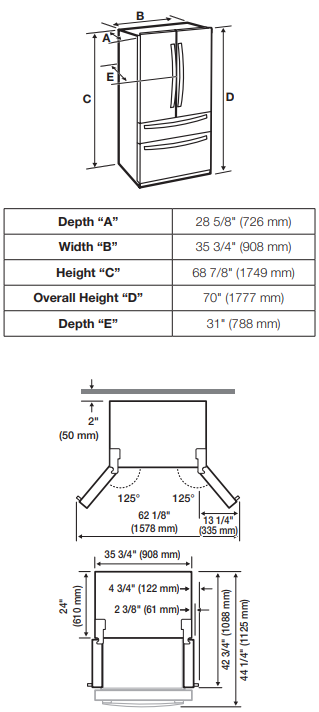
FLOORING
- For proper installation, you must place this refrigerator on a level, hard surface that is the same height as the rest of the floor. This surface should be strong enough to support a fully loaded refrigerator.
- To protect the finish of the flooring, cut a large section of the cardboard carton and place it under the refrigerator where you are working. When moving the refrigerator, you need to pull and push it straight forwards or back. Do not wiggle it from side to side.
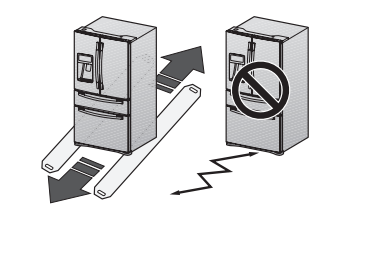
REMOVING THE REFRIGERATOR DOORS
- For some installations you need to remove the fridge and freezer drawers so you can move the refrigerator to its final location. Do not remove the doors/drawer if you don’t need to. If you do not need to remove the refrigerator doors, go to Adjusting the Level on page 14. If you need to remove the doors. continue below.
- Before removing the door/drawer, make sure you read the following items:
- Disconnect power to the refrigerator before removing the door or drawer.
- Be careful not to drop, damage, or scratch the doors/drawers while removing them.
- Use care when you remove the doors/drawers.
- The doors are heavy and you could injure yourself.
- Reattach the doors/drawers properly to avoid:
- Moisture from air leakage.
- Uneven door alignment.
- Wasting energy due to improper door seal.
CAUTION
If a red clip is on the coupler, you must remove it before removing the tube.
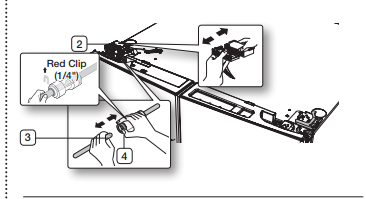
Pull and remove the hinge lever ( 5 ). Remove the ground screw ( 6 ) attached to the upper left door hinges with a philips screwdriver (+). Remove the upper left and right door hinges
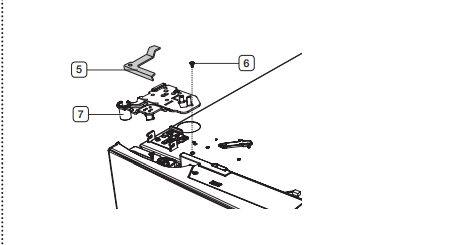
Lift the door straight up to remove

Remove the screw ( 8 ) attached to the lower left and right door hinges with a philips screwdriver (+).
Remove the 2 hex head bolts ( 9 ) attached to the lower left and right door hinges with an allen wrench (3/16”). Remove the lower left and right door hinges ( 10 )
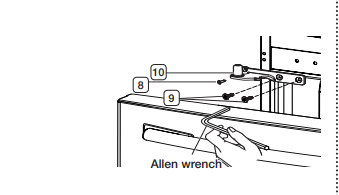
RE-ATTACHING THE REFRIGERATOR DOORS
To reattach the fridge doors after you have moved the fridge to its final location, assemble the parts in reverse order.
The Water Line must be fully inserted into the center of the transparent coupler (Type A) or the Guide Lines (Type B) to prevent water leakage from the dispenser.
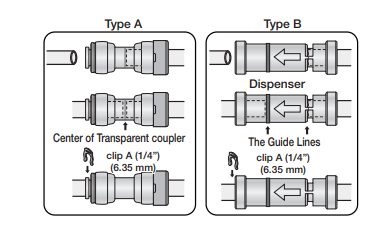
Insert the clip in the install pack and check that it holds the line firmly
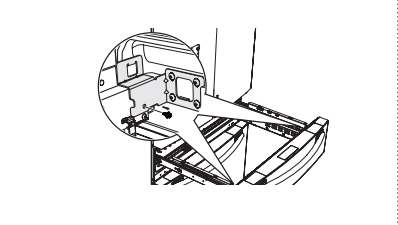
Remove 1 hex head bolt from each side with a socket wrench (10 mm).
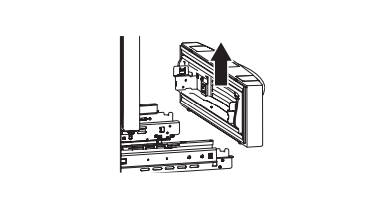
Lift up the Flex door from the rails.
ADJUSTING THE LEVEL
- Make sure the refrigerator is level so that you can make final adjustments. Use a level to test if the refrigerator is level both side to side and back to front.
- If the refrigerator is not level, you will not be able to get the doors perfectly even, which may cause moisture condensation and increased energy bills. Below is an example of how to level the refrigerator if the left side of the refrigerator is lower than the right side.
How to adjust the level
- Open the freezer drawer and remove the lower basket.
- Insert a flat-blade screwdriver (-) into the notch on the left control lever, and turn it counterclockwise to level the refrigerator. (You turn the lever clockwise to lower the refrigerator and counterclockwise to raise it.) flat-blade screwdriver (-) Control Lever
- Both control levers must be touching the floor to avoid possible personal injury or property damage because of tipping.
- If the right side is lower, perform the same procedure, but with the right control lever.
- It is difficult to remove the cover leg front from the refrigerator, so we do not recommend making small adjustments with the control lever.
- Instead, refer to the next page for the best way to make minor adjustments to the doors.
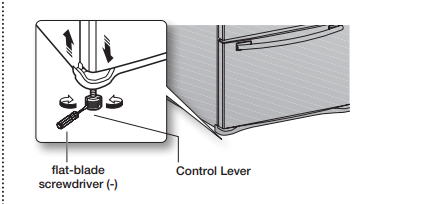
DISPENSER LINE
- A water dispenser with a filter is one of the helpful features on your new refrigerator. To help promote better health, the water filter removes unwanted particles from your water. However, it does not sterilize the water or destroy microorganisms. You may need to purchase a water purifying system to do that.
- The water line also connects to the ice maker.
- For the ice maker to operate properly, water pressure of 20-125 psi (138 ~ 862 kPa) is required.
- If the refrigerator is installed in an area with low water pressure (below 20 psi), you can install a booster pump to compensate for the low pressure.
- After you have connected the water line, make sure the water storage tank inside the refrigerator is properly filled. To do this, press the water dispenser lever until the water runs from the water outlet.
Connecting to the water supply line
- First, shut off the main water supply.
- Locate the nearest cold water drinking line and install the pipe clamp and shut off valve.
- Pipe clamp
- Cold water line
- Shut off valve
- Connect the water line installation kit to the shut off valve.

Connecting the water supply line to the refrigerator.
There are several items that you need to purchase to complete this connection. You may find these items sold as a kit at your local hardware store.

Connect the household water line to the assembled compression fitting. If you are using copper tubing, slip the compression nut ( B ) (not supplied) and ferrule (not supplied) on the copper tubing (not supplied) as shown.
If you are using plastic tubing ( B ) , insert the molded end (Bulb) of the plastic tubing ( B ) into the compression fitting.
COMPLETING THE SET UP
- Now that you have your new refrigerator installed in place, you are ready to set up and enjoy the features and functions of the appliance.
- By completing the following steps, your refrigerator should be fully operational.
- Make sure your refrigerator is in an appropriate location with reasonable clearance between it and the wall. Refer to installation instructions in this manual.
- Once the refrigerator is plugged in, make sure the interior light comes on when you open the doors.
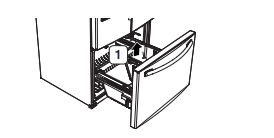
- Set the Temperature control to the coldest temperature and wait for an hour. The freezer will get slightly chilled and the motor will run smoothly. Reset the refrigerator and freezer to the temperatures you want.
- After you plug the refrigerator in, it will take a few hours to reach the appropriate temperature. You can store food and drinks in the refrigerator after the temperature is sufficiently cool.
MAKING MINOR ADJUSTMENTS TO THE DOORS
- Remember, a leveled refrigerator is necessary for getting the doors perfectly even. If you need help, review the previous section on leveling the refrigerator.
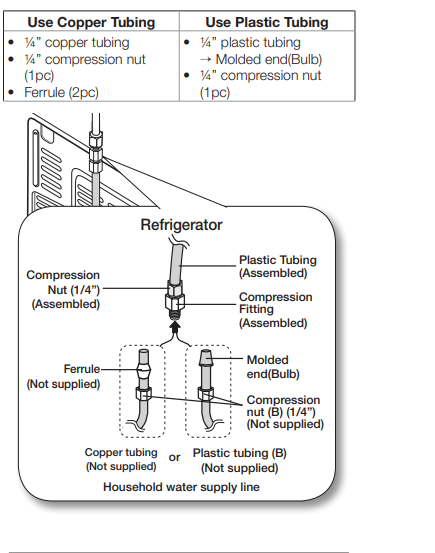
Adjustment
- Fixed part part
- The left door is fixed. To make minor door adjustments, adjust only the right door.
- Pull out the flex door ( 1 ) to reveal the lower hinge ( 2 ).
- Insert a philips screwdriver (+) ( 3 ) into the shaft ( 4 ) of the lower hinge.
- Adjust the height by turning a philips screwdriver (+) clockwise ( DOWN ) or counterclockwise ( UP ).
- When you turn a philips screwdriver (+) counterclockwise ( ), the door will move up

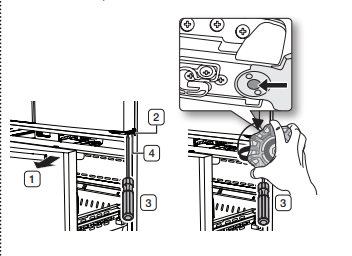
INSTALLING
INSTALLING THE WATER DISPENSER LINE
- A water dispenser with a filter is one of the helpful features on your new refrigerator. To help promote better health, the water filter removes unwanted particles from your water. However, it does not sterilize or destroy microorganisms. You may need to purchase a water purifying system to do that.
- The water line also connects to the ice maker.
- For the ice maker to operate properly, water pressure of 20-125 psi (138 ~ 862 kPa) is required.
- If the refrigerator is installed in an area with low water pressure (below 20 psi), you can install a booster pump to compensate for the low pressure.
- After you have connected the water line, make sure the water storage tank inside the refrigerator is properly filled. To do this, press the water dispenser lever until the water runs from the water outlet.
- Water line installation kits are available at extra cost from your dealer.
- We recommend using a water line installation kit that contains copper tubing and ¼” compression nut.
Connecting to the water supply line
- First, shut off the main water supply.
- Locate the nearest cold water drinking line and install the pipe clamp and shut off valve.
- Pipe clamp
- Cold water line
- Shut off valve
- Connect the water line installation kit to the shut off valve.
- Connecting the water supply line to the refrigerator.
- There are several items that you need to purchase to complete this connection.
- You may find these items sold as a kit at your local hardware store.
- Use Copper Tubing Use Plastic Tubing copper tubing compression nut pc)
- Ferrule (2pc) plastic tubing
- Molded end(Bulb) compression nut pc)
Compression
- Nut (1/4”)
- Assembled)
- Ferrule
- Not supplied)
- Plastic Tubing
- Assembled)
- Compression
- Fitting
- Assembled)
- Molded end(Bulb)
- Compression nut (A) (1/4”)
- Not supplied) or Copper tubing
- Not supplied)
- Plastic tubing (B)
- Not supplied)
- Household water supply line
Refrigerator
- Connect the household water line to the assembled compression fitting.
- If you are using copper tubing, slip the compression nut ( A ) (not supplied) and ferrule (not supplied) on the copper tubing (not supplied) as shown.
- If you are using plastic tubing ( B ) , insert the molded end (Bulb) of the plastic tubing ( B ) into the compression fitting.
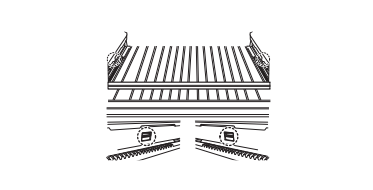
- Do not use without the molded end (Bulb) of the plastic tubing ( B ).
- Tighten the compression nut ( A ) onto the compression fitting.
- Do not over-tighten the compression nut ( A ).
COMPLETING THE SET UP
- Now that you have your new refrigerator installed in place, you are ready to set up and enjoy the features and functions of the appliance.
- By completing the following steps, your refrigerator should be fully operational.
- Make sure your refrigerator is in an appropriate location with reasonable clearance between it and the wall. Refer to installation instructions in this manual.
- Once the refrigerator is plugged in, make sure the interior light comes on when you open the doors.
- Set the Temperature control to the coldest temperature and wait for an hour. The freezer will get slightly chilled and the motor will run smoothly. Reset the refrigerator and freezer to the temperatures you want.
- After you plug the refrigerator in, it will take a few hours to reach the appropriate temperature. You can store food and drinks in the refrigerator after the temperature is sufficiently cool.
- If condensation or water drops appears on both sides of fridge door’s central part, turn the Energy Saver mode off after removing the condensation. (See the explanation on Energy Saver button in the
Operating your French Door Refrigerator
USING THE CONTROL PANEL

Freezer/ Power Freeze (3sec)
- The Freezer button serves two purposes: - To set the Freezer to your desired temperature. - To turn the Power Freeze function on and off. 1) To set the Freezer temperature, touch the Freezer button. You can set the temperature between 5 °F (-15 °C) and -8 °F (-23 °C). 2)
- Power Freeze function Touch and hold this button for 3 seconds to decrease the time needed to freeze products in the Freezer. It can be helpful if you need to quickly freeze easily spoiled items or if the temperature in the freezer has warmed dramatically (For example, if the door was left open). When you use this function, the energy consumption of the refrigerator will increase.
- Remember to turn it off when you don’t need it and return the freezer to your original temperature setting. If you need to freeze a large amount of food, activate the Power Freeze function at least 24 hours before you put the food into the freezer. ( 2 )
Alarm/ Filter Reset sec)
- The Alarm button serves two purposes:
- To turn the door open alarm on and off
- To reset the water filter life indicator.
Door Alarm Function
- If the door alarm is set to On, an alarm beeps if any refrigerator door is left open for more than three minutes. The beeping stops when you close the door. The door alarm function is pre-set to On in the factory. You can turn it off by pressing and then releasing the Alarm button. You can turn it back on in the same fashion. The icon lights up when the function is on.
- When the Door Alarm function is on and the alarm sound is triggered, the Door
- Alarm Icon will blink while the alarm sounds.
- Water Filter Life Indicator Function
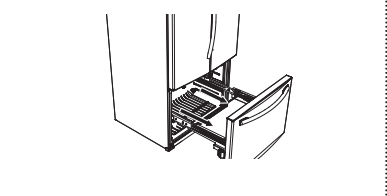
- After you replace the water filter, touch and hold this button for 3 seconds to reset the water filter life indicator. When you reset the water filter life indicator, the Filter icon on the panel turns Off. The
- Filter icon will turn red to let you know it is time to change the water filter after six months (about 300 gallons). Some areas have large amounts of lime in their water, which causes the water filter to clog more quickly. If this is the case in your area, you will have to change the filter more frequently than every six months.
Energy
- Saver Touching this button turns Energy Saver mode on and off. When you turn Energy
- Saver on, the Energy Saver icon lights.
- Turn Energy Saver off and the icon goes off. The Energy Saver function’s factory setting is “ON”. If condensation or water drops appear on the doors, turn the
- Energy Saver mode off.
Fridge/Power Cool sec)
- The Fridge button serves two purposes:
- To set the Fridge to your desired temperature.
- To turn the Power Cool function on
- To set the Fridge temperature, press the Fridge button. You can set the
Power Cool function
- Touch and hold this button for 3 seconds to decrease the time needed to cool products in the Refrigerator.
- It can be helpful if you need to quickly cool easily spoiled items or if the temperature in the fridge has warmed dramatically (for example, if the door was left open)
Ice Maker Control Lock
- To turn the Control Lock Function on
- If you don’t want to make more ice, press
Control Lock Function
- Touch and hold this button for 3 seconds to lock the display, the Flex Zone panel, and the dispenser buttons so the buttons can not be used.
- When Control Lock is on, the refrigerator does not dispense ice or water, even if the
- Dispenser Lever is pressed.
- The Control Lock icon lights up to indicate you’ve activated the Control Lock function. Press 3 seconds to unlock.
Lighting/C ↔ ºF sec
- The Lighting button serves two purposes:
- To switch the temperature units between ºC and ºF
Light Function
- Touching the Lighting button turns on the Dispenser LED lamp in continuous mode so that it stays on continuously.
- The button also lights up. If you want the
- Dispenser lamp to come on only when some one uses the dispenser, press the
- Lighting button to turn the continuous
- To switch the temperature units between ºC and ºF
- Touch and hold this button for 3 seconds to select the temperature display you want.
- Each time you press and hold the button, the ºC and ºF temperature modes alternate and the ºC or ºF icon lights up, indicating your selection.
Filter Water filter usage
- This icon lights up when you need to change the filter, usually after the refrigerator has dispensed about 300 gallons of water (after about 6 months).
- After you install the new water filter, reset the filter indicator by touching and holding sec for Filter Reset button for 3 seconds.
- If water is not dispensing or dispensing slowly, you need to replace the water filter because the water filter is clogged.
- Some areas have large amounts of lime in their water, which causes the water filter to clog more quickly
CHANGING THE WATER FILTER
- To reduce risk of water damage to your property DO NOT use generic brands of water filters in your SAMSUNG Refrigerator.
USE ONLY SAMSUNG BRAND
- WATER FILTERS. SAMSUNG is not legally responsible for any damage, including, but not limited to, property damage caused by water leakage from the use of a generic water filter. SAMSUNG
- Refrigerators are designed to work
ONLY WITH SAMSUNG Water Filters. Red
- The Filter light turns red to let you know when it is time to change your water filter cartridge.
- To give you time to get a new filter, the red light comes on just before the capacity of the current filter runs out.
- Changing the filter on time provides you with the freshest, cleanest water from your refrigerator.
- Shut off the water supply. Then, turn the water filter ( 1 ) about 1/4 turn, counter-clockwise.
- Pull the water filter ( 1 ) from the case filter ( 2 ).
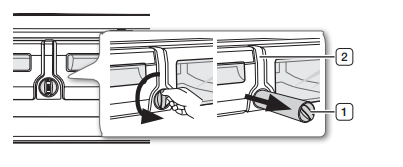
To change the water filter more easily, shut off the water supply valve.
Sometimes, it is hard to disassemble the water filter because impurities in the water cause it to stick. If you are having difficulties, grip the water filter firmly and pull it hard.

When you pull the water filter, a little water can leak from the opening. This is normal.
To minimize the water leaks, keep the filter cartridge horizontal when you pull it.
To prevent overflow, empty the water tray filter and dry around of case filter ( 2 ).
The Fridge button serves two purposes:
- To set the Fridge to your desired temperature.
- To turn the Power Cool function on and off.
- To set the Fridge temperature, press the Fridge button. You can set the temperature between 44 °F (7 °C) and F (1 °C).
Power Cool function
- Touch and hold this button for 3 seconds to decrease the time needed to cool products in the Refrigerator.
- It can be helpful if you need to quickly cool easily spoiled items or if the temperature in the fridge has warmed dramatically (for example, if the door was left open).
Lighting/ C ↔ ºF sec
- The Lighting button serves two purposes:
- To turn the dispenser light on and off
- To switch the temperature units between ºC and ºF
Light Function
- Touching the Lighting button turns on the
- Dispenser LED lamp in continuous mode so that it stays on continuously.
- The button also lights up. If you want the
- Dispenser lamp to come on only when some one uses the dispenser, press the
- Lighting button to turn the continuous mode off.
- To switch the temperature units between ºC and ºF
- Touch and hold this button for 3 seconds to select the temperature display you want.
- Each time you press and hold the button, the ºC and ºF temperature modes alternate and the ºC or ºF icon lights up, indicating your selection.
Ice MakerOff/ Control Lock
- The Ice Maker Off button serves two purposes:
- To turn the Ice maker on and off
- To turn the Control Lock Function on and off.
Ice Off Function
- If you don’t want to make more ice, press the Ice Maker Off button.
Control Lock Function
- Touch and hold this button for 3 seconds to lock the display, the Flex Zone panel, and the dispenser buttons so the buttons can not be used.
- When Control Lock is on, the refrigerator does not dispense ice or water, even if the
- Dispenser Lever is pressed.
- The Control Lock icon lights up to indicate you’ve activated the Control Lock function. Press 3 seconds to unlock.
- Water Touch this button to dispense water. This mode can not be used with the Ice Type mode simultaneously.
- Water mode shuts off when you touch the
- Cubed/Crushed Ice button.
Filter
- Water filter usage
- This icon lights up when you need to change the filter, usually after the refrigerator has dispensed about 300 gallons of water (after about 6 months).
- The icon will blink red for several seconds when you open or close the door.
- After you install the new water filter, reset the filter indicator by touching and holding the Hold 3 sec for Filter Reset button for seconds.
- If water is not dispensing or dispensing slowly, you need to replace the water filter because the water filter is clogged.
- Some areas have large amounts of lime in their water, which causes the water filter to clog more quickly.
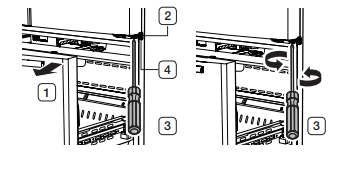
Ice Type
- Touch this button to select your desired ice type. Cubed and crushed ice modes alternate when you press the button. This mode can not be used with the Water mode simultaneously
CHANGING THE WATER FILTER
- To reduce the risk of water damage to your property DO NOT use generic brands of water filters in your SAMSUNG Refrigerator.
USE ONLY SAMSUNG BRAND WATER FILTERS.
- SAMSUNG is not legally responsible for any damage, including, but not limited to, property damage caused by water leakage from the use of a generic water filter. SAMSUNG Refrigerators are designed to work ONLY WITH
SAMSUNG Water Filters.
- The Filter light turns red to let you know when it is time to change your water filter cartridge.
- To give you time to get a new filter, the red light comes on just before the capacity of the current filter runs out. Changing the filter on time provides you with the freshest, cleanest water from your refrigerator.
To change the water filter, follow these steps:
- Shut off the water supply. Then, turn the water filter ( 1 ) about 1/4 turn, counter-clockwise.
- Pull the water filter ( 1 ) from the case filter ( 2 ).
- To change the water filter more easily, shut off the water supply valve.
- Sometimes, it is hard to disassemble the water filter because impurities in the water cause it to stick. If you are having difficulties, grip the water filter firmly and pull it hard.
- When you pull the water filter, a little water can leak from the opening. This is normal.
- To minimize the water leaks, keep the filter cartridge horizontal when you pull it.
- To prevent overflow, empty the water filter tray and dry around the filter case ( 2 ).
- Insert the new filter into the filter case (
Maintaining the Ice Bucket
- To clean the ice bin/bucket, wash with a mild detergent, rinse well, and dry thoroughly it. Do not use harsh or abrasive cleaners or solvents.
- Ice is made in cubes. When you select
- Crushed”, the ice maker grinds the ice cubes into crushed ice.
- When you select Cubed Ice after using the
- Crushed Ice mode, a small amount of residual crushed ice might be produced.
- The ice cubes generated by the rapid ice making process will look white, which indicates they were generated normally.
- As the ice maker in the refrigerator room makes ice cubes even faster, move the ice cubes from the refrigerator ice bin to the freezer ice bin if you need more ice cubes.
- If ice doesn’t come out, pull out the ice bucket and press the test button located on the right side of ice maker. See the illustration below.
- Do not press the test button continuously when the tra
Basic temperature of Freezer and fridge compartments
- The basic and recommended temperatures of the
- Freezer and Fridge compartments are 0 °F and
- F (or -18 °C and 3 °C) respectively.
- If the temperature of the Freezer and Fridge compartments are too high or low, adjust the temperature manually
Controlling the Freezer temperature
- Recommend Temp (Freezer) : 0 °F (or -18 °C )
- The Freezer temperature can be set between -8 °F and 5 °F (or between -23 °C and -15 °C) to suit your particular needs.
- Press the Freezer button repeatedly until the desired temperature is shown in the temperature display.
- The temperature will change by 1 °F (or 1 °C) with each press. See below.
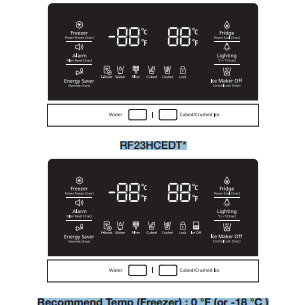
Controlling the fridge temperature
- Recommend Temp (Fridge) : 37 °F (or 3 °C )
- The fridge temperature can be set between 34 °F and 44 °F (or between 1 °C and 7 °C) to suit your particular needs.
- Press the Fridge button repeatedly until the desired temperature is shown in the temperature display.
- The temperature will change by 1 °F (or 1 °C) with each press. See below.
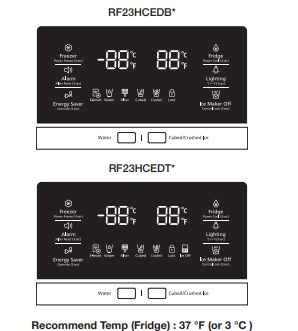
filled with ice or water. Water may overflow or ice may jam the bucket.
Using the ice off Function
When you select the Ice Off mode, remove all ice cubes from the bucket.
- If you leave the ice cubes in the bucket, the ice cubes may clump together, making it difficult to remove them.
- To remove the ice bucket safely and avoid injury, hold the bottom of the bucket with one hand and the side of the bucket with the other.
- Then, lift up on the ice bucket, and pull it straight out.
- To put the ice bucket back in, push it firmly straight back.
- If the ice bucket is not pushed firmly into place, ice in the bucket can melt.
- If the bucket does not fit, turn the helix 90 degree see the last illustration on the right, below) and try again.
- The inside of the ice bucket is very cold when the refrigerator is operating.
- Do not reach deep inside the ice bucket.
- Use only the ice maker provided with the refrigerator. The water supply to this refrigerator must only be installed/connected by a suitably qualified person.
- Connect to a potable water supply only.
- To operate the ice maker properly, water pressure of 20 ~ 125 psi is required.
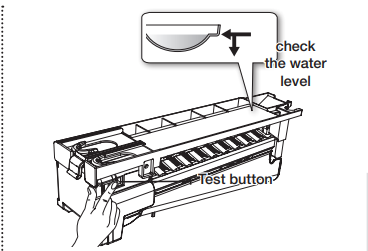
Water clouding phenomenon
- All water provided to the refrigerator flows through the core filter which is an alkaline water filter. In the filtering process, the pressure of the water that has flowed out of the filter is increased, and the water becomes saturated with oxygen and nitrogen.
- When this water flows out into the air, the pressure plummets and the oxygen and nitrogen get supersaturated, which results in gas bubbles
- The water may temporarily look misty or cloudy due to these oxygen bubbles. After a few seconds, the water will look clear.
Ice Maker Do’s and Don’ts
- Do not put your fingers, hands or any other unsuitable objects in the chute or ice-maker bucket
- It may result in personal injury or material damage.
- Never put your finger or any other objects in the dispenser opening.
- It may cause injury.
- Do not try to disassemble the ice maker.
- Do not wash or spray the ice bucket with water while it is in the refrigerator. Remove it to clean it
- When you insert the Ice maker tray, be sure that the tray is well centered at the entrance.
- Otherwise, the tray may get stuck.
PARTS AND FEATURES
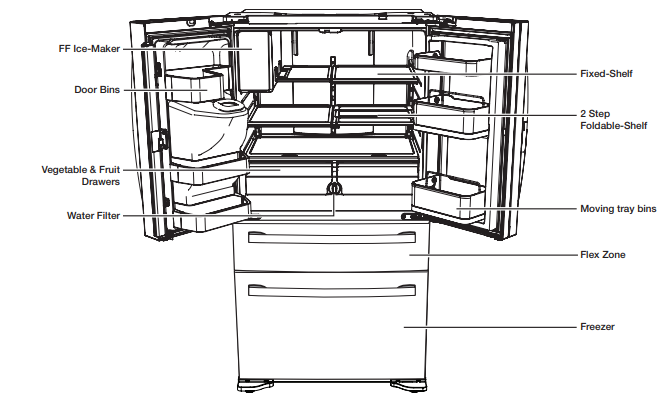
USING FLEX ZONE
- The Flex Zone is a full-width drawer with an adjustable temperature control. You can use the
- Flex Zone for large party trays, deli items, wines, pizzas, beverages, or miscellaneous items. There is a temperature sensor which lets you adjust the amount of cold air allowed into the Zone.
- The control buttons are located on the cap door center.

Temperature Selection Button
- Press the Temp button repeatedly until your desired mode is lit.
- Each time you press the Temp button, you change the mode in this order: Meat/Fish mode (29 °F (-1 °C)), Cold Drinks mode (33 °F
- Deli/Snack mode (37 °F (3 °C)), Wine
- Party Dishes mode (42 °F (5 °C)). Initially, the
- Cold Drinks mode is selected. The refrigerator will adjust the temperature in the Flex Zone automatically to the temperature you selected.
- The Flex Zone Temp. Display may change depending on the number of items inside, where they are located, the ambient temperature, and how often the door is opened.
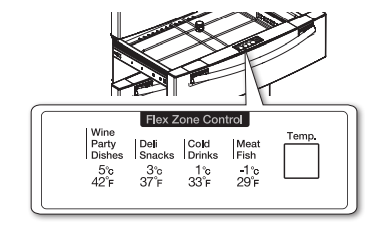
Flex Zone Modes
- When “Wine/Party Dishes” is selected, the temperature of the Flex Zone will be kept around 42 °F (5 °C). This feature helps keep food fresh for a long time.
- When “Deli/Snack” is selected, the temperature of the Flex Zone will be kept around 37 °F (3 °C). This feature helps keep food fresh for a longer time.
- When “Cold Drink” is selected, the temperature of the Flex Zone will be kept around 33 °F (1 °C). This feature helps keep drinks cold and refreshing.
- When “Meat/Fish” is selected, the temperature of the Flex Zone will be kept around 29 °F (-1 °C). This feature helps keep meat or fish fresh for a longer time.
- Examples of food items you can store in the Flex
- Zone by temperature setting.
Selection Button
- When “Wine/Party Dishes” is selected, the temperature of the Flex Zone will be kept around 42 °F (5 °C). This feature helps keep food fresh for a long time.
- When “Deli/Snack” is selected, the temperature of the Flex Zone will be kept around 37 °F (3 °C). This feature helps keep food fresh for a longer time.
- When “Cold Drink” is selected, the temperature of the Flex Zone will be kept around 33 °F (1 °C). This feature helps keep drinks cold and refreshing.
- When “Meat/Fish” is selected, the temperature of the Flex Zone will be kept around 29 °F (-1 °C). This feature helps keep meat or fish fresh for a longer time.
- Examples of food items you can store in the Flex
- Zone by temperature setting.
RECOMMENDED LOCATION FOR THE FOLDABLE SHELF
- The Foldable Shelf folds up from the center, giving you more storage area for tall items without your having to re-arrange the shelves.
- Install the Foldable Shelf on the right side of the refrigerator.
- If you install the Foldable Shelf on the left side, the ice maker will prevent the shelf from folding completely.
- To use, push the front portion of the shelf back gently so that the shelf folds up from the middle.
- How to use the Multi Supporter
- When not in use, leave the Multi Supporter flipped over as shown in the diagram.
- Flip the Multi Supporter to position (1) to prevent items from falling out and over.
- Flip the Multi Supporter to position (2) to use it as a divider.
Tempered Glass shelves
- To remove - Tilt up the front of the shelf in the direction shown (1) and lift it up vertically (2). Pull the shelf out.
- To re-install - Tilt the front of the shelf up and guide the shelf hooks into the slots at a desired height. Then lower the front of the shelf so that the hooks can drop into the slots.
- The Tempered Glass shelves are heavy.
CAUTION
- Use special care when removing them.
Foldable Shelf
- To remove - After removing the Shelf Front, lift up the Shelf and remove it.
- To re-install - Hook the Shelf on the Angle Frame and re-attach the Shelf Front to the Foldable Shelf.
- After sliding the foldable shelf in and folding it, the Shelf Front can be removed for your convenience. If you use the self without removing, be careful of its possible separation.
Flex Zone
- To remove the Flex Zone – Pull the Flex door out to full extension. Lift the Flex Zone up, pulling it to your body with both hands.
- To re-install the Flex Zone – Open the Flex door to full extension. Tilt the front of the Flex Zone up, place the back of the Flex Zone onto the rails, and then lower the front until the whole Zone rests on the rails.
Super Extended Drawer
- To remove - Pull the drawer out to full extension.
- Tilt up the rear of the drawer and lift straight out.
- To re-install - Place the drawer onto the rails ( 4 ) by tilting it up. Lower the drawer into place until it is horizontal and slide the Drawer ( 3 ) in.
Freezer Drawer
- To remove the freezer drawer - Pull the freezer drawer out fully. Tilt up the rear of the bin and lift it out to remove.
- To re-install the freezer drawer - Place the bin into the rail assembly.
- You can scratch the side of the bin if you twist it left or right when disassembling or re-assembling it.
- Do not allow babies or children go inside the freezer drawer. They could damage the refrigerator and seriously injure themselves. Do not sit on the freezer door.
- The door may break. Do not allow children to climb into the freezer drawer.
- Do not remove the divider.
CLEANING THE REFRIGERATOR
Cleaning the Interior
- Clean the inside walls and accessories with a mild detergent and then wipe dry with a soft cloth. You can remove the drawers and shelves for a more thorough cleaning.
- Just make sure to dry drawers and shelves before putting them back into place.
Cleaning the Exterior
- Wipe the control panel and digital display with a damp, clean, soft cloth. Do not spray water directly on the surface of the refrigerator.
- The doors, handles, and cabinet surfaces should be cleaned with a mild detergent and then wiped dry with a soft cloth. To keep your appliance looking its best, polish the exterior once or twice a year.
- Do not spray water directly on the refrigerator. Use a clean, damp cloth to clean.
- Do not use benzene, thinner, or Clorox for cleaning. They may damage the surface of the appliance and may cause a fire.
- You can erase the printed letters on the display if you apply stainless cleaner directly to the area where the letters are printed.
Cleaning the Ice / Water Dispenser
- Wipe the Ice / Water Dispenser with a clean, soft cloth.
- When using the crushed ice selection from the dispenser some residual ice chips may start to collect in the ice chute. To prevent that residual ice from melting and running out of the chute, you should clean out the residual ice when you see it start to collect in the ice chute.
Cleaning the Rubber door seals
- If the rubber door seals are dirty, the doors may not close properly, and the refrigerator will not operate efficiently. Keep the door seals free of dust or stains by cleaning the doors using a mild detergent and damp cloth. Wipe dry with a clean, soft cloth.
- Do not clean the refrigerator with benzene, thinner, or car detergent. These substances could cause a fire.
Cleaning the rear side of the refrigerator
- To keep cords and exposed parts free of dust and dirt accumulation, vacuum the rear side of the appliance once or twice a year.
- Do not remove the back cover ( 1 ).
- You could suffer an electric shock.
FOOD STORAGE TIPS
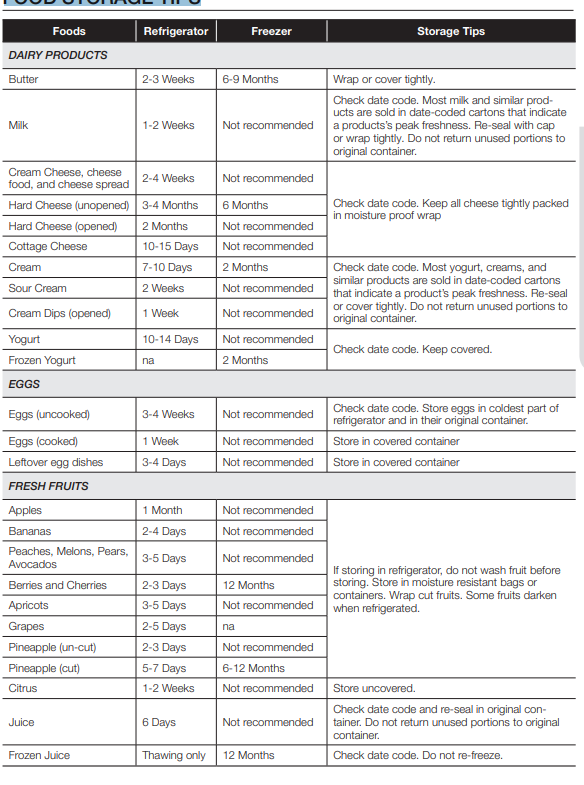
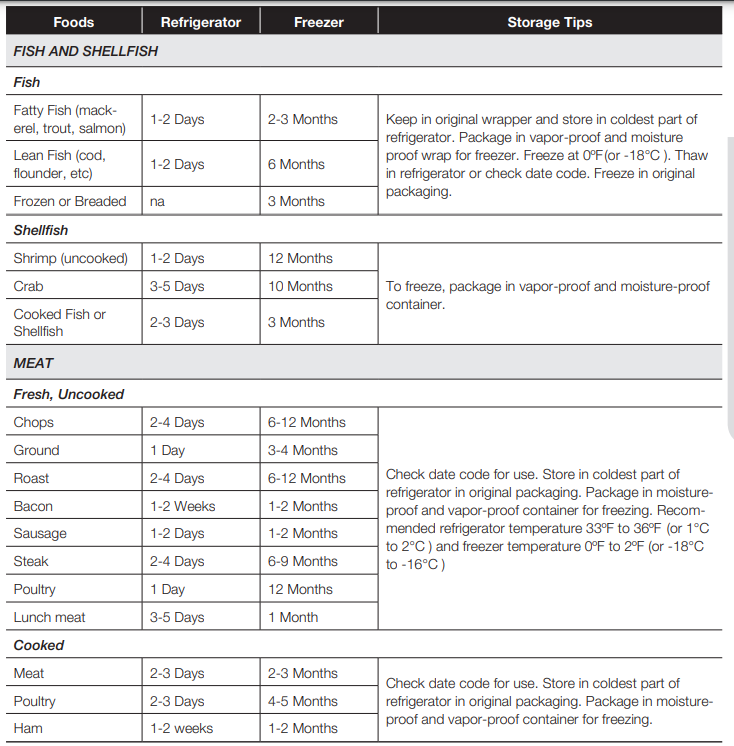
Troubleshooting
The refrigerator does not work at all or it does not chill sufficiently.
- Check that the power plug is properly connected.
- Check if the set temperature on the digital display is warmer than the freezer or fridge inner temperature. If it is, set the refrigerator colder.
- Is the refrigerator in direct sunlight or located near a heat source?
- Is the back of the refrigerator too close to the wall, preventing proper ventilation?
The food in the fridge is frozen.
- Check if the set temperature on the digital display is too low.
- Try setting the refrigerator to a warmer temperature.
- Is the temperature in the room too low? Set the refrigerator warmer.
- Did you store the food which is juicy in the coldest part of the refrigerator?
- Try moving those items to the other shelves in the fridge instead of keeping them in the colder areas or bins.
You hear unusual noise or sounds.
- Check that the refrigerator is level and stable.
- Is the back of the refrigerator too close to the wall, preventing proper ventilation?
- Try moving the back of the refrigerator at least 2 inches from the wall.
- Was anything dropped behind or under the refrigerator?
- A “ticking” sound is heard from inside the refrigerator. It is normal and occurs because various accessories are contracting or expanding according to the temperature of the refrigerator interior.
- If it sounds as if something is hitting something else inside the refrigerator, this is normal. The sound is caused by the compressor operating at high capacity
The cabinetdoor sealing area of the appliance is hot and condensation is occurring.
• Some heat is normal as anti-condensators are installed in the vertical hinged section of the refrigerator to prevent condensation.
• Is the refrigerator door ajar? Condensation can occur when you leave the door open for a long time.
Ice Maker is not producing ice.
• Did you wait for 12 hours after installing the water supply line before making ice?
• Is the water line connected and the shut-off valve opened?
• Did you manually stop the ice making function?
• Is the freezer temperature too warm? Try setting the freezer temperature lower.
There is a bad smell in the refrigerator.
• Check for spoiled food.
• Foods with strong odors (for example, fish) should be tightly covered.
• Clean out your freezer periodically and throw away any spoiled or suspicious food.
Frost forms on the walls of the freezer.
• Is the air vent blocked? Remove any obstructions so air can circulate freely.
• Allow sufficient space between the stored food for efficient air circulation.
• Is the freezer drawer closed properly?
Water dispenser is not functioning.
• Is the water line connected and the shut-off valve opened?
• Has the water supply line tubing been crushed or kinked?
• Make sure the tubing is free and clear of any obstruction.
• Is the water tank frozen because the fridge temperature is too low? Try selecting a warmer setting on the Digital display.
• Is the Child Lock on?
Auto close system does not work with the freezer door.
• Is there an imbalance between the right and left parts of the door?
• Open and close the door smoothly 1~2 times. After you do this, the auto close system usually works properly again
• Try opening the door smoothly to avoid unbalancing the right part and the left part of the door
Condensation or water drops forms on both sides of fridge door’s central part.
• Condensation or water drops may form if the humidity is too high while the refrigerator is operating.
• If condensation or water drops appears on both sides of fridge door’s central part, turn the Energy Saver mode off after removing the condensation. (See the explanation on Energy Saver button in the USING THE CONTROL PANEL.)
See other models: WA50R5200AW WF45R6300AV/US DVE50R5400V/A3 RF20HFENBSR/US RF22R7351DT/AA
